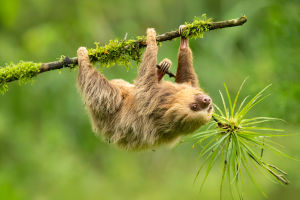Squirrel monkeys are fascinating creatures! They belong to the New World primates and are known for their squirrel-like appearance. These small, energetic monkeys are mostly found in South America, where they thrive in a variety of habitats.
With their distinct features and lively social behavior, they are truly unique animals. In this article, we'll explore everything we need to know about squirrel monkeys, from their appearance to their diet and the challenges they face in the wild.
What Makes Squirrel Monkeys Unique?
Squirrel monkeys are a type of primate in the “Cebidae” family. They are known for their small size and distinctive features, one of the most notable being their long tail with a black tip. When fully grown, a squirrel monkey can reach lengths of up to 80 cm (about 31 inches), and they typically weigh around 1.5 kilograms (about 3.3 pounds). Their face is another prominent feature, with a white spot on the face and a brown nose that makes them easy to recognize. Squirrel monkeys are often confused with other members of the same family, like the Saimiri and the Saimiri sciureus, but they have their own unique traits that set them apart.
These monkeys are also known for their love of forests. While some primates can adapt to a variety of habitats, squirrel monkeys are particularly fond of living in forests, including gallery forests, low-canopy hardwood forests, and even wetlands. They can often be found in areas with high humidity or even in partially flooded forests and mangroves. Interestingly, squirrel monkeys can adapt to various types of forests, provided they find all the necessary resources like water and food. This adaptability helps them thrive, despite the continuous threats from habitat destruction caused by human activities.
Social Life of Squirrel Monkeys
One of the most fascinating aspects of squirrel monkeys is their highly social behavior. These primates are not territorial, which means they tend to live in large groups, ranging from 10 to over 400 individuals. Depending on their environment, squirrel monkey groups can be made up of males, females, and their offspring. They interact with each other and form strong social bonds, which is crucial for their survival. These groups are very cooperative, helping each other in finding food and protecting one another from predators.
Squirrel monkeys usually live in mixed-age groups, where different generations can help each other. This social structure ensures that the group is always ready to defend itself against threats and share responsibilities like caring for the young. Despite their social nature, squirrel monkeys rarely come into conflict with other groups, as they are not territorial and typically stay within their own habitat boundaries.
Diet and Feeding Habits
When it comes to food, squirrel monkeys are omnivores with a preference for fruits and insects. Their diet consists of a variety of foods, including nuts, berries, seeds, plants, and small invertebrates like ants, butterflies, and spiders. They also occasionally consume small vertebrates. Despite their small digestive systems, squirrel monkeys obtain more protein from insects than from fruits, making them highly skilled at foraging for their food.
Squirrel monkeys are diurnal, meaning they are active during the day. In the early morning, they search for fruits to eat, while in the afternoon, they focus more on hunting for insects. Their feeding behavior is somewhat similar to that of the Saimiri bolivianus, with a preference for high-energy foods like fruits and small insects that provide the nutrients they need to stay active.
Threats to Squirrel Monkeys
Unfortunately, squirrel monkeys are facing serious threats to their survival. One of the main dangers they face is habitat destruction, as large areas of forests are being cleared for agriculture and urban development. This loss of habitat leaves squirrel monkeys with fewer places to live and find food. Additionally, they are often targeted by poachers and are sold in the commercial pet trade. This illegal activity further threatens their survival, as it disrupts their natural social structure and can lead to the loss of entire populations.
Squirrel monkeys are also vulnerable to environmental changes, including climate change and human-induced destruction of their natural habitats. While these monkeys are adaptable, the increasing pressures from deforestation and human activities are making it harder for them to thrive. Protecting their habitats and ensuring that they have access to resources like food and water are crucial to their survival.
Conservation Efforts
As the threats to squirrel monkeys continue to rise, it's more important than ever to support conservation efforts aimed at protecting these incredible animals. Many organizations are working to preserve their habitats and prevent the illegal pet trade. By supporting these efforts and spreading awareness about the importance of protecting squirrel monkeys, we can help ensure that future generations will be able to experience the beauty and wonder of these small, lively primates.
In conclusion, squirrel monkeys are amazing creatures that deserve our attention and protection. Their social nature, unique appearance, and diverse diet make them stand out in the world of primates. However, they are facing serious challenges due to habitat destruction, poaching, and climate change. It's up to us, Lykkers, to help raise awareness and protect these incredible animals so that they can continue to thrive in the wild for years to come.


